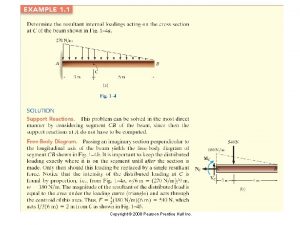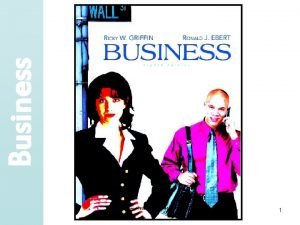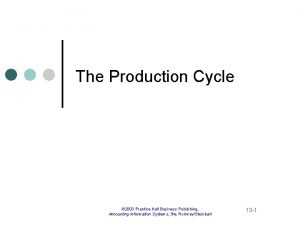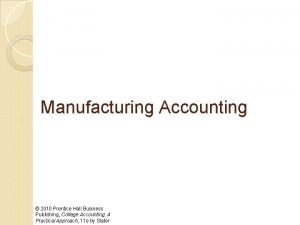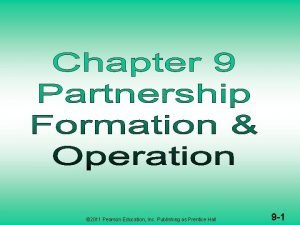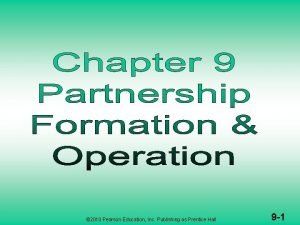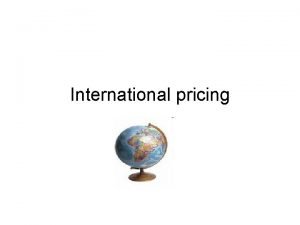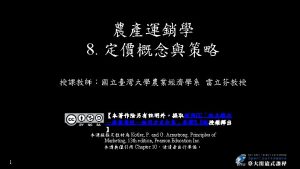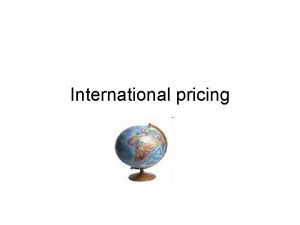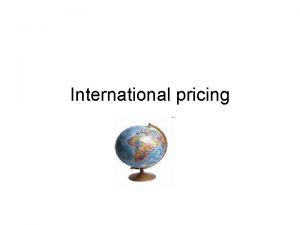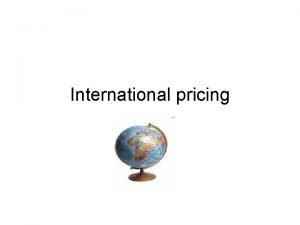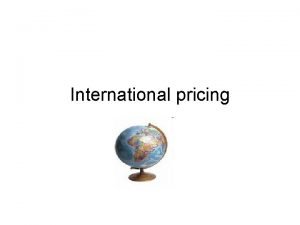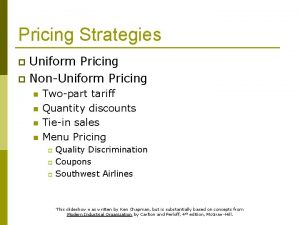Chapter 11 Pricing Decisions 2005 Prentice Hall 11


































- Slides: 34

Chapter 11 Pricing Decisions © 2005 Prentice Hall 11 -1

Pricing in the global market Theoretical perfect competition – one price everywhere – Forex market, ICs, crude oil Country differences in price reflect – – Factor cost differences (e. g. labor costs) Level of competition (e. g. airfares in the US and India) Taxes (different sales tax structures) Internet brings transparency to prices (e. g. music / software sold on the net) – Life cycle stage (introductory stage products vs. maturity products) © 2005 Prentice Hall 2

The price band & price points Floor prices – set by product costs Ceiling prices – set by competing products – Available / discretionary income (“what the traffic can bear”) – Perceptions of value Optimum price – Maximize sales & profits © 2005 Prentice Hall 3

Global Pricing Objectives and Strategies Managers must determine the pricing objectives – Financial objectives (e. g. profits, recovery of costs, ROI, etc. ) – Non-financial objectives (e. g. capturing market share, increasing sales, etc. ) Basic pricing strategies to achieve those objectives – Market Skimming – Penetration Pricing © 2005 Prentice Hall 4

Market Skimming and Financial Objectives Market Skimming – Charging a premium price – Introduction stage of product life cycle – “make hay while the sun shines”- Suitable for products which obsolete fast – Innovations / Inventions © 2005 Prentice Hall Sony Ad. for camcorders 5

Penetration Pricing and Non. Financial Objectives Penetration Pricing – Charging a low price in order to penetrate market quickly – Appropriate to saturate market prior to imitation by competitors 1979 Sony Walkman © 2005 Prentice Hall 6

Some Creative Pricing Strategies Companion Pricing – – Two related products “One cannot do without the other” High switching costs E. g. cellphone plans, razors and blades, computers and software, video games and console, etc. Price Bundling – Two unrelated products – Offered at a price greater than the cost of the more expensive one but less than the cost of both if sold separately © 2005 Prentice Hall 7

Companion Products whose sale is dependent upon the sale of primary product – Video games are dependent upon the sale of the game Console “If you make money on the blades you can give away the razors. ” X-Box Game System and Sports Game © 2005 Prentice Hall 8

US vs. Japanese approaches to pricing Begin with perceptual mapping and product definition In the US: – design, engineering, marketing and other costs are added on – This constitutes the product cost In Japan – Planned selling price is determined and desired profit is subtracted – Balance represents target cost for all design, engineering, marketing and other activities © 2005 Prentice Hall 9

Rigid cost plus pricing Price = costs of products + freight + insurance + local costs +…+ profit No regard to country-specific conditions like market prices, govt. laws about dumping, pricing strategies, reflection of quality, incomes, etc. Generally used by first time exporters with little or no international experience May result in severe price escalation / overpricing/under-pricing © 2005 Prentice Hall 10

Flexible Cost plus pricing Flexible cost-plus pricing ensures that prices are competitive in the context of the particular market environment Great attention to country-specific conditions Used by experienced exporters Can result in great profitability © 2005 Prentice Hall 11

Terms of the Sale Obtain export license if required Obtain currency permit Pack goods for export Transport goods to place of departure Prepare a land bill of lading Complete necessary customs export papers Prepare customs or consular invoices Arrange for ocean freight and preparation Obtain marine insurance and certificate of the policy © 2005 Prentice Hall 12

Terms of the Sale Incoterms – Ex-works – seller places goods at the disposal of the buyer at the time specified in the contract; buyer takes delivery at the premises of the seller and bears all risks and expenses from that point on. – Delivery duty paid – seller agrees to deliver the goods to the buyer at the place he or she names in the country of import with all costs, including duties, paid. © 2005 Prentice Hall 13

Incoterms FAS (free alongside ship) named port of destination – seller places goods alongside the vessel or other mode of transport and pays all charges up to that point FOB (free on board) – seller’s responsibility does not end until goods have actually been placed aboard ship CIF (cost, insurance, freight) named port of destination – risk of loss or damage of goods is transferred to buyer once goods have passed the ship’s rail CFR (cost and freight) – seller is not responsible at any point outside of factory Return © 2005 Prentice Hall 14

Environmental Influences on Pricing Decisions Currency Fluctuations Inflationary Environment Government Controls, Subsidies, Regulations Competitive Behavior Sourcing © 2005 Prentice Hall 15

Currency Fluctuations Return © 2005 Prentice Hall 16

Pricing strategies accounting for currency fluctuations Market holding strategy – using flexible pricing during unfavorable currency swings – Objective: maintain market share – Risk: long term unviability Marginal Cost pricing – pricing to cover variable costs of additional production in a weak currency country – Objective: aggressive market share capture – Risk: Dumping allegations © 2005 Prentice Hall 17

Inflationary Environment Defined as a persistent upward change in price levels – Can be caused by an increase in the money supply – Can be caused by currency devaluation – Can be caused by strong demand weak supply of goods Essential requirement for pricing is the maintenance of operating margins – Cover price increases of inputs Return © 2005 Prentice Hall 18

Government Controls, Subsidies, and Regulations The types of policies and regulations that affect pricing decisions are: – Dumping legislation – Price controls (e. g. DPCO in India) – Subsidies to local businesses Return © 2005 Prentice Hall 19

Competitive Behavior If competitors do not adjust their prices in response to rising costs it is difficult to adjust your pricing to maintain operating margins If competitors are manufacturing or sourcing in a lower-cost country, it may be necessary to cut prices to stay competitive e. g. Levis in the US and abroad. Return © 2005 Prentice Hall 20

Using Sourcing as a Strategic Pricing Tool Marketers of domestically manufactured finished products may move to offshore sourcing of certain components to keep costs down and prices competitive Can you stay competitive while staying local? Return © 2005 Prentice Hall 21

Recommend a pricing strategy Givenchy introduces a new high fashion product (e. g. formal gowns) in the US. Typical PLC is about a year. Competition in the fashion industry is intense Pfizer introduces a new patented drug – In US – In India. Govt. regulates drug prices © 2005 Prentice Hall 22

Recommend a pricing strategy Toyota introduces a new economy sub-compact car in Indonesia. The car is manufactured in Japan. The Indonesian Rupaiah is weak and inflation is high Ford pioneers the introduction of a fuel cell car – In the US. Gas prices are rising. GM, Chrysler, Toyota and Honda are poised to introduce their models – In India. Gas is expensive. Car is manufactured in the US. The dollar is strong; the rupee is weak but is becoming stronger. Indian incomes are rising. There is no competition on the horizon. – In Saudi Arabia. Gas is cheap and plentiful. © 2005 Prentice Hall 23

Recommend a pricing strategy Boeing introduces the 7 E 7 to – Air France – Singapore Airlines – Delta Airlines Motorola introduces the Razr (cell phone) – In US – In India © 2005 Prentice Hall 24

Global Pricing: Three Policy Alternatives Extension Adaptation Geocentric © 2005 Prentice Hall 25

Extension Ethnocentric Per-unit price of an item is the same no matter where in the world the buyer is located (e. g. Mattel toys, Mercedes cars) Importer must absorb freight and import duties Fails to respond to each national market Return © 2005 Prentice Hall 26

Adaptation Polycentric Permits affiliate managers or independent distributors to establish price as they feel is most desirable in their circumstances Sensitive to market conditions but creates potential for arbitraging E. g. prices of books, drugs, etc. Return © 2005 Prentice Hall 27

Geocentric Intermediate course of action Recognizes that several factors are relevant to pricing decision – Local costs (lower costs may justify lower prices) – Income levels (high income levels may justify higher prices) – Competition – Local marketing strategy May standardize a price band within which regions / countries may vary prices according to local conditions Return © 2005 Prentice Hall 28

Gray Market Goods Trademarked products are exported from one country to another where they are sold by unauthorized persons or organizations Occurs when product is in short supply, when producers use skimming strategies in some markets, and when goods are subject to substantial mark-ups © 2005 Prentice Hall 29

Dumping Sale of an imported product at a price lower than that normally charged in a domestic market or country of origin. Occurs when imports sold in the US market are priced at either levels that represent less than the cost of production plus an 8% profit margin or at levels below those prevailing in the producing countries To prove, both price discrimination and injury must be shown © 2005 Prentice Hall 30

Price Fixing Representatives of two or more companies secretly set similar prices for their products – Illegal act because it is anticompetitive Horizontal price fixing occurs when competitors within an industry that make and market the same product conspire to keep prices high e. g. ADM and enzyme used in animal feed. Vertical price fixing occurs when a manufacture conspires with wholesalers/retailers to ensure certain retail prices are maintained. E. g. De. Beers industrial diamonds. © 2005 Prentice Hall 31

Transfer Pricing of goods, services, and intangible property bought and sold by operating units or divisions of a company doing business with an affiliate in another jurisdiction Cross-border exchanges constitute a sale Intra-corporate exchanges – Cost-based transfer pricing – Market-based transfer pricing – Negotiated transfer pricing © 2005 Prentice Hall 32

Countertrade occurs when payment is made in some form other than money e. g. when hard currency is scarce. Options – Barter (e. g. Pepsico and Stolichnaya imports from USSR in exchange for concentrate) – Counter-purchase (money exchange involved but transaction not complete unless a separate purchase is also made – e. g. Rockwell / Zimbabwe) © 2005 Prentice Hall 33

Countertrade – Offset (LDCs request exporters to buy the LDCs products in an effort to regain scarce forex e. g. Boeing and China) – Compensation trading (also called buyback – e. g. supplier building a plant in exchange for buying back a certain percentage of its output for several years, as payment for the plant) – Switch trading (third party steps in to take unwanted goods at a fee) © 2005 Prentice Hall 34
 Copyright 2005 pearson prentice hall inc
Copyright 2005 pearson prentice hall inc 2005 pearson prentice hall inc
2005 pearson prentice hall inc Poster making meaning
Poster making meaning 2008 pearson prentice hall inc
2008 pearson prentice hall inc Pearson prentice hall
Pearson prentice hall 2008 pearson prentice hall inc
2008 pearson prentice hall inc Pearson prentice hall
Pearson prentice hall Prentice hall inc
Prentice hall inc Prentice hall careers
Prentice hall careers Prentice hall america pathways to the present
Prentice hall america pathways to the present Pearson education inc publishing as pearson prentice hall
Pearson education inc publishing as pearson prentice hall Prentice hall publishing
Prentice hall publishing Prentice hall african american history
Prentice hall african american history Prentice hall physical science concepts in action
Prentice hall physical science concepts in action 2011 pearson education inc
2011 pearson education inc Pearson prentice hall
Pearson prentice hall Pearson prentice hall
Pearson prentice hall Pearson education inc publishing as pearson prentice hall
Pearson education inc publishing as pearson prentice hall Common name of arthropoda
Common name of arthropoda Prentice hall business publishing
Prentice hall business publishing Pearson education inc. publishing as prentice hall
Pearson education inc. publishing as prentice hall Pearson education 2012
Pearson education 2012 Pearson education inc. 2012
Pearson education inc. 2012 Chapter 4 job costing
Chapter 4 job costing Pearson education inc. publishing as prentice hall
Pearson education inc. publishing as prentice hall Pearson education inc. publishing as prentice hall
Pearson education inc. publishing as prentice hall Pearson education inc. publishing as prentice hall
Pearson education inc. publishing as prentice hall 2010 pearson education inc
2010 pearson education inc Screening decisions and preference decisions
Screening decisions and preference decisions Pricing policies
Pricing policies Pricing and output decisions in perfect competition
Pricing and output decisions in perfect competition Pricing decision and cost management
Pricing decision and cost management Pricing: making profitable decisions
Pricing: making profitable decisions What is ode
What is ode Jules prentice
Jules prentice




